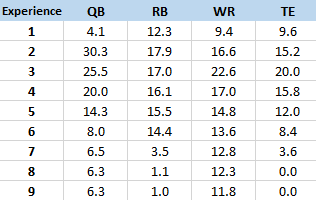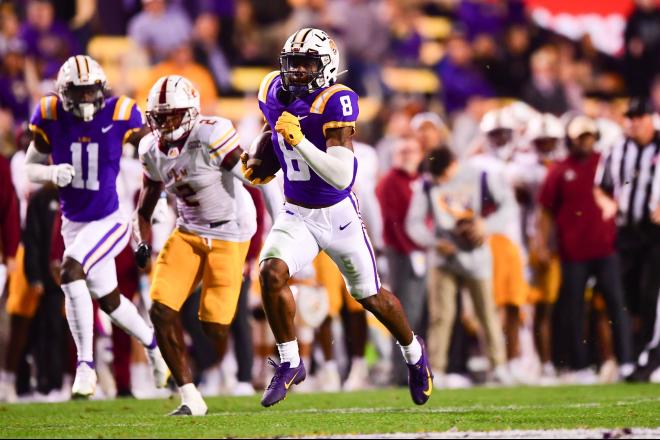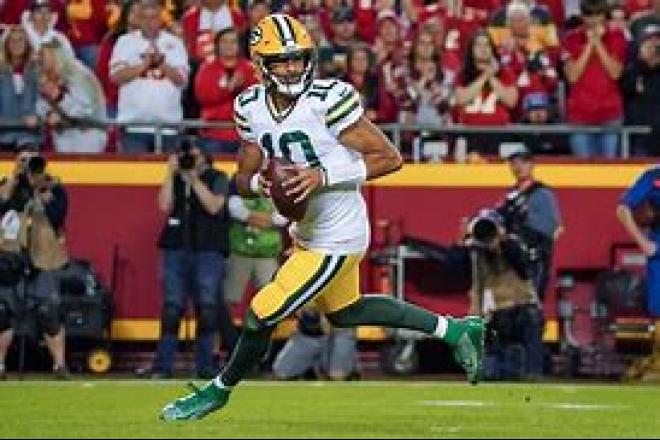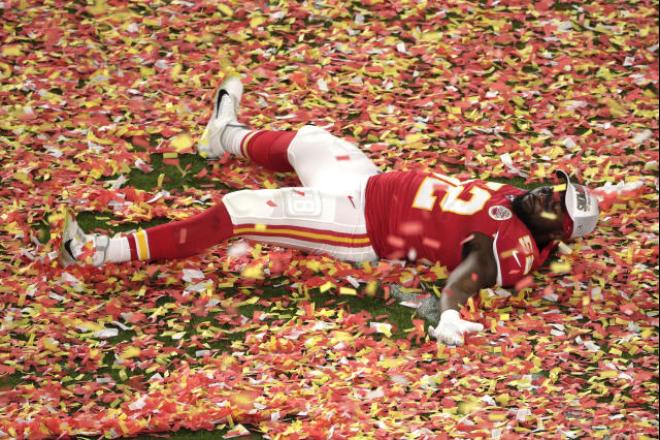Truly I have been looking forward to writing is an article because I didn't know how it would turn out, and it solidifies my plan for my 2024 dynasty rookie draft.
Introduction
First, this article builds off of my previous four articles:
- How To Add A QB1 To Your FF Dynasty Team
- How To Add An RB1 To Your FF Dynasty Team
- How To Add A WR1 To Your FF Dynasty Team
- How To Add A TE1 To Your FF Dynasty Team
I will recap the important points here incase you don't have the time to go back and read them. They each correlate the average draft position (ADP) of rookies over the last nine years with how they performed since. My goal was to learn from history the true value of picks (based on success rate of picking a starter) and learning of the developmental and waning periods of players by position.
Before I dive in further, I want to give my standard disclaimer. Past results are no guarantee of future results. It is said history doesn't repeat, but it rhymes. The information presented herein should be taken in that spirit.
Furthermore, my study assumes I am dumber than a doornail when it comes to assessing the potential of individual NFL players, rookies and veterans. If I know nothing about players at all, and just wanted to give myself the best chance of winning based on the statistics we can derive from past success, this is how I would do it.
Of course, if you believe you have better football knowledge than the consensus of all other dynasty fantasy football players, (and there is about a 50% chance that you do), then you should use that knowledge to your advantage.
As for me, I want to do both - go by the odds of the past and then beat those odds with football knowledge. I will explain what this means specifically as we dive in. Besides this brief (umm, long-winded and boring) introduction, the article has four sections:
- Success Rate versus ADP
- Success Rate versus Years in the NFL
- The Ultimate (An Exceptional???) My Humble Dynasty Draft Plan
- Detailed Data Tables
ADP versus Success Rate
I have reviewed the results in-depth since writing the previous articles, smoothed out the curves, and with no further udo (drum roll) here are the results:
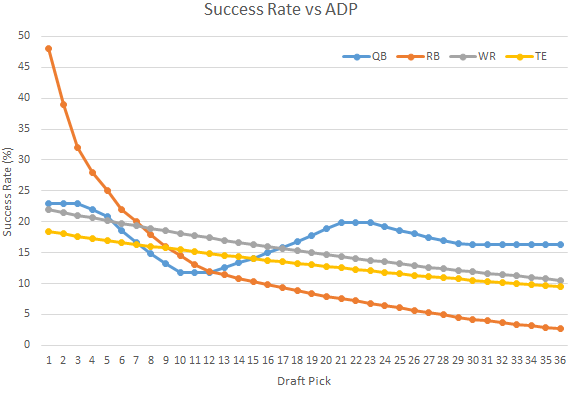
In the previous articles I assigned values based on a player's ranking at the end of each of the last nine football seasons. Because my starting lineup requires 1 QB, 2 RBs, 3 WRs, 1 TE (and a FLEX, K and Def) I used a different rating system for each position. Here are the rating systems:
- QB: 1 for top-6, 0.5 for 7-12
- RB: 1 for top-6, 0.75 for 7-12, 0.50 for 13-18, 0.25 for 19-24
- WR: 1 for top-6, 0.75 for 7-12, 0.50 for 13-18, 0.375 for 19-24, 0.25 for 25-30, 0.125 for 31-36
- TE: 1 for top-6, 0.5 for 7-12
Then I integrated the results of all players across all years and obtained "Success Rate" versus ADP. In the chart above I smoothed out the results to what I thought to be reasonable and accurate.
I include the detailed data of the above graph at the end of this article.
QB Results Summary
The quarterback results look strange. The success rate of the actual data was actually a little bit higher in the bottom of the 2nd to 1st half of the 3rd round than it was in the first round. If you want to be convinced of that success rate bump in the lower rounds of the draft, here are some names to consider:
- Patrick Mahomes, Jalen Hurts, Justin Herbert, Josh Allen, Lamar Jackson, Daniel Jones, Derek Carr, Jared Goff, Deshaun Watson and Carson Wentz all had rookie ADPs in the bottom half of a 3-round draft (or in Hurts' case, even lower).
- Trey Lance, Teddy Bridgewater, Marcus Mariota, Zach Wilson, Dwyane Haskins, Tau Tagovailoa, Mac Jones and Johnny Manziel all had 1st round rookie ADPs
My hypothesis - for what it's worth (I am sure that along with $15 you can buy your favorite cup of coffee and a half gallon of gas) - is that college QB skills and NFL Combine results don't translate into the NFL as well as we think. And what happens is in pre-season we start to see quarterbacks emerge that we didn't expect, and so we draft them in the lower rounds. Again, this is just a hypothesis backed by tons of (absolutely no) data.
Do the collective masses and the mainstream prognosticators know better now than they did over the last nine years? Perhaps they do and perhaps they don't. I don't know - your guess is as good as mine. As for me, I will plan to draft in rhyme with history and I will get to the details of that below in the last section.
RB Results Summary
The running back results are clear. Top picks get top running backs. Since we value running backs so highly for dynasty, they are drafted very heavily in rookie drafts so that by the time we get to the bottom of the 3rd round we are picking the last bits of sinew off the bone. Historically the most sure dynasty draft picks are the first two picks off the board for running backs. These are the running backs drafted as the top or the 2nd overall pick over the last 9 years: Todd Gurley, Ezekiel Elliot, Leonard Fournette, Christian McCaffrey, Saquon Barkley, Royce Freeman, Josh Jacobs, David Montgomery, Clyde Edwards-Helaire, Jonathon Tyler, Najee Harris and Breece Hall. Of course this is not a 100% success rate, but hopefully you recognize at least a couple of these names.
It's obvious the best way to get a top running back is to draft 1.01 or 1.02 in your dynasty rookie draft, and mostly you are wasting your pick if you are taking dart throws at running backs in the bottom of the 3rd round. We will get into more draft strategy at the end of this article.
WR Results Summary
The correlation between ADP and WR success is much flatter than with running back. Historically, if you draft two wide receivers with the last two picks of the third round, you would have an equal chance that one of these WR would be successful as if you drafted a WR with the 1.01 pick, specifically the odds are 10.8% and 10.6% for the last two picks of the 3rd round, or 21.4% that one of them would be successful, compared with the 22.0% chance that a 1.01 WR will be successful. Rookie WRs with 1.01 or 1.02 ADP in the last nine years are Sammy Watkins, Mike Evans, Amari Cooper, Corey Coleman and Drake London. WRs with an ADP of 35 or 36 in the last nine years include Stefon Diggs, Isaiah Ford, Equanimeous St Brown, Kelvin Harmon, and Tyreek Hill's ADP was lower than 36.
The data was very smooth and regular across all three rounds and a high number of WRs are drafted every year, so I believe this result can be trusted.
TE Results Summary
Only 26 tight ends have a rookie ADP in the top three rounds over the last nine years, thus the data is sparse. And given the draft success of TEs, its no wonder why they are sparsely drafted. In my full TE analysis I concluded that TE performance is based more on their situation than on their skillset. A TE's primary purpose in the NFL is blocking. Running routes and catching the ball and scoring touchdowns is a secondary role that some TEs play when the coaching, game plan, game situation and the quarterback's preference all align. Of course trends change, but if history rhymes, we generally don't need to worry too much about drafting rookie TEs unless you really believe you have identified the next Rob Gronkowski or Travis Kelce, and they have landed in a Rob Gronkowski and Travis Kelce like situation (e.g. a head coach and/or offensive coordinator that likes to use TEs as receivers, the QBs best-buddy, etc.) Most head coaches are going to care mostly that their green-behind-the-ears NFL rookie TE learns how to pick up his blocking assignments long before he gets a major role as a receiver.
These TEs all have a rookie ADP in the 3rd round: Mark Andrews, George Kittle, Tyler Higbee, Darren Waller, Logan Thomas, Taysom Hill, Dalton Schultz, Juwan Johnson and Dawson Knox.
Years of Experience vs Success Rate
The following chart shows success rate of players by position versus years of experience.
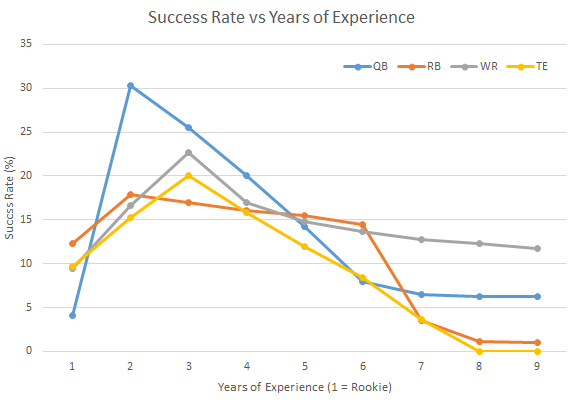
I used my judgement to smooth out the raw data a bit so we could more easily discern the trends.
QB Trend
The quarterback position is the least likely to be successful in the first year (4%), but that all changes dramatically in the second year. They are the most likely to be successful in the 2nd year (30%), and they drop after that leveling out at about a 6% success rate from year 7 and on.
RB Trend
The running back position is the most likely to be successful in the first year (12.3%), rises to its peak in the 2nd year (17.9%) and not dropping off much through year 6. Then the running back has a dramatic drop-off in year 7.
WR Trend
The WR has a three-year learning curve, rising from a 9.4% probability of success the first year, to 22.6% in his 3rd year. Although there is some drop off after the 3rd year, the WR position stays stable all the way out through 9 years. In fact, the 9-year WR has a higher success rate (11.8%) than the rookie.
TE Trend
You might be wondering about Travis Kelce and Rob Gronkowski. They were drafted more than 9 years back and so are not part of this study. I don't have the data going back more than 9 years, so I don't know how many TEs had rookie ADPs in the first 3 rounds more than 9 years ago. In any case, even if Rob Gronkowski and Travis Kelce were included in the study, the success rate out in years 8 and 9 would still be very low (in the 4 or 5% range).
For the first five years, the TE has a similar success rate curve as WRs. But they drop off compared with WRs in year six. Also, a review of the detailed data in the original article shows that tight ends are very unpredictable. Their performance comes in and goes out of the top 12 frequently. One tight end might be successful in year 1, and another tight end that was not successful for six years, might all of a sudden be successful in years 7 and 8. (Again, successful for fantasy purposes in this context means a top-12 TE with twice as much value given to a top-6 TE verses the 7th through 12th ranked TE).
As mentioned above some of the arbitrary nature of the performance of TEs is likely due to the fact that receiving is generally a secondary role.
I include the detailed data of the above graph at the end of this article.
The Ultimate Dynasty Draft Plan
Okay, the results are in, and the indication is clear.
Always draft a running back with a 1.01 or a 1.02 pick. That's it. That's the plan.
Alright, I guess you need a little convincing. Let me explain.
The purpose is to get the most success value out of every pick you make. Two picks have far more value than any other picks in the draft, and those two picks are the 1.01 and 1.02.
Using my strategy to build a repository of picks, this year, I have the 1.07, 1.08, 1.09, 2.03, 2.05, 2.12 and 3.04. I came in 3rd place last year, after having the 2nd highest score in my league in a decade in Week 14, and the highest total points through our three playoff weeks, Weeks 15 through 17. I lost in the semi-finals. I came in 2nd place the year before. So I don't obtain these draft picks because my team did badly or because I had a fire sale. I purpose to keep both a pick arsenal and a competitive team at all times. It is a "DYNASTY" league - that's the goal. If you burn up everything you have to win just for one year, and then go back to rebuilding, you aren't building a dynasty - you are building a one-and-done team.
If you want to build a dynasty, you have to have a multi-year strategy. So aside from my football knowledge, and indicating who my favorite players are, here is exactly what I plan to do with each of my picks:
1.07 (Value 20% RB, 19.4% WR, 18.7% QB, 16.7% TE):
- Plan A: Trade it forward into 2024 for a first round pick of a team that I project will do poorly this year. My hope is that I land the 1.01 or 1.02 2024 pick. Even with a random role of the dice, I have a 50% chance the pick will end up higher than the current 1.07, and will therefore be worth more next year. Worst case, I could end up with the 1.12 (if a team I projected to do poorly happens to come in first place - very unlikely), then I would end up with the 1.12 and step backwards, but not by that much. The 1.12 value is 17.4% WR, 14.9% TE, 12% RB, 11.9% QB.
- Plan B: Trade it forward into 2024 for a first round and second round pick of a team that I project might do average or well this year. Even the 2.12 has a value of 19.2% QB, 13.5% WR, 11.8% TE, 6.5% RB. So if I get the 1.12 and 2.12, I am way ahead of the game, but I am not any closer to my goal of getting the 1.01 or 1.02 pick.
- Plan C: Trade it for a 2nd or 3rd year player that started making progress near the end of last year, and is in a good position to jump in performance this year. The success rate for 2nd year players is higher for all positions than for rookies, and for 3rd year players, it is higher for WRs and TEs compared with 2nd year players.
- Plan D: I could trade down to get more picks later in the draft which sum-up to more value than the 1.07, but I have so many later picks, I will probably make a pick. There really isn't much difference in value per position with the 1.07 pick, so I would pick based on need, which for me is a running back, unless there is a player that I believe has generational talent, that happens to fall that far in the draft.
1.08 (Value 18.9% WR, 18% RB, 16.1% TE, 14.9% QB):
- I would follow basically the same plan as for my 1.07 pick.
1.09 (Value 18.6% WR, 16% RB, 15.8% TE, 13.3% QB):
- Ditto 1.09.
2.03 (Value 16.3% WR, 14.3% TE, 13.3% QB, 10.3% RB)
- Plan A: The 1.12 pick is only three draft picks higher, and with pre-season draft hype and the feeling of opening presents on Christmas morning when we get the shiny new and unblemished rookies, I have found that it is often possible to trade a high 2nd round pick for a projected low 1st round pick on draft day. If I can make that steal of a deal I will do it without hesitation. Then in 2024, I can trade that 1.11 or 1.12 for a mid-round 1st, and before long I am knocking at the door of 1.01 or 1.02. The goal is to work the odds in my favor every step of the way, and remember that I am building a dynasty, not a one-and-done. I must remain patient.
- Plan B: Trade it forward for two 2nd round picks. Again, with all the hype going on during the pre-season, I might get away with this, especially because it is a high 2nd round pick. I won't worry if I end up with two low 2nd round picks. Look at the value chart, and you see the overall value of two low second round picks is far greater than the 2.03 pick.
- Plan C: Plan C depends on how many picks I have traded into the future at this point, and how much real space I have on my roster. If I have been successful to trade away one or two of my first round picks, I would trade the 2.03 down for a low 2nd round pick and a high 3rd. I would land right in the sweet spot for finding a QB and the success rate of WRs and TEs doesn't drop off fast. Furthermore, I might be able to trade those lower picks I just picked up for future higher 2024 picks.
- Plan D: Make my best pick, most likely for WR based on the success valuations.
2.05 (Value 15.9% QB, 15.6% WR, 13.5% TE, 9.3% RB)
- Plan A: It depends on what happens with 2.03, but if I ended up with another 3rd round pick, I would try to trade the 2.05 plus a 3rd for a 2024 1st round pick. It probably won't happen, but that mainstream hype, all those mainstream "secret" sleeper articles, and the fun of making rookie draft picks, with the feeling of opening presents on Christmas morning, could be enough to pull it off. Nothing is rational when it comes to the draft, and that is the time to strike - while there is chaos and lots of emotion.
- Plan B, C and D: Ditto 2.03.
2.12 (Value 19.2% QB, 13.5% WR, 11.8% TE, 6.5% RB)
- Plan A: Now this is where it gets interesting. I can try to trade forward for a 2024 second round pick, and I would have a 91.7% chance that I would be moving up in the 2024 draft compared with the 2.12. However, my first choice will be to carefully assess the rookie QBs that are still on the board and see if any are starting to pop in the pre-season. I know it doesn't sound likely that this will happen, but I will remember the list of stud QBs drafted in this range. Here is where I might find the next Patrick Mahomes. Again, I haven't decided I will draft a QB here, but I am going to pay special attention, and decide at that time.
- Plan B: Trade forward for a 2024 2nd round pick.
- Plan C: It is really a shame to use a bottom of the round pick to make a pick because usually it is very easy to move up in the round by trading into the future, but if I were left with no choice but to make a pick here, I would certainly pick the best player I thought was still on the board - if after doing my analysis on QBs (Plan A) I didn't find a QB, I would be looking at WRs and TEs next.
3.04 (Value 17.0% QB, 12.4% WR, 11% TE, 4.9% RB)
- Plan A: I will try to trade this forward for a low 2024 2nd round pick. The 2.12 pick is only 4 picks earlier, and with all the hype during fantasy football draft season, I can usually get a 2nd round pick from a high 3rd round pick. The league might be wising up to me - but you can't blame a guy for trying again.
- Plan B: I will check the draft board, how much space I have on my roster, etc., and decide if I will try to split this pick into two 3rd round picks - one lower in the 2023 draft and one future in the 2024 draft. If there are a couple of players I like about equally at this point in the draft, I will try to make that trade, and just pick whichever player falls to the later pick. If there is only one player I really want at this point in the draft, I will just pick the player.
My goal is to come out of the draft with both a better team and a greater, more valuable, arsenal of picks for 2024. Of course orthogonal to this study of just pure statistics is doing my homework on exactly who I would draft at each point in the draft if I end up needing to make a pick. I get excited about the players too, and I have my favorites and I like the excitement of the shiny new rookies on my team just as much as anyone else. So I am not afraid to make picks, but I am trying to push my emotions aside and use the objective power of math to build a dynasty.
Finally, let's say my plan works perfectly, and year after year, I am drafting only running backs with the 1.01 and 1.02 pick, how do I fill the other positions? Well that is the easiest problem in the world to solve. Top RBs have ultimate trade value in dynasty fantasy football. If I have more top RBs than I need, I just trade one for a top-6 and a top-24 of other positions anytime I need. Unfortunately I haven't had that problem yet - but if it happens it will be a very good problem to have.
So you see, I am serious about the very simple plan of only drafting RBs with the 1.01 and 1.02. It won't work out that way every year, but it is the ultimate goal.
Detailed Data Tables
This is the detailed Success Value (%) versus ADP table to help you make both pick and trade decisions:
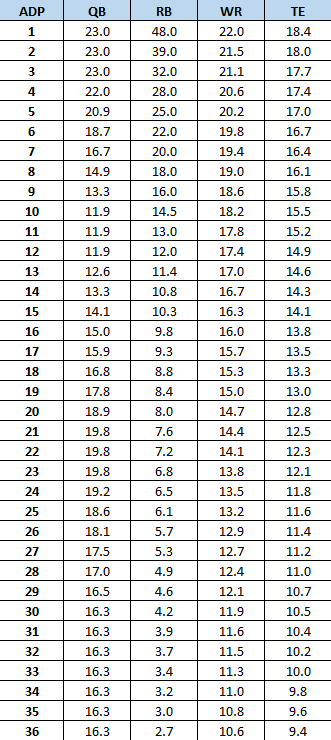
This is the detailed Success Value (%) versus Years Experience table to help you identify players you might want to try to trade for before they have fantasy relevance or trade away before they fade away:
